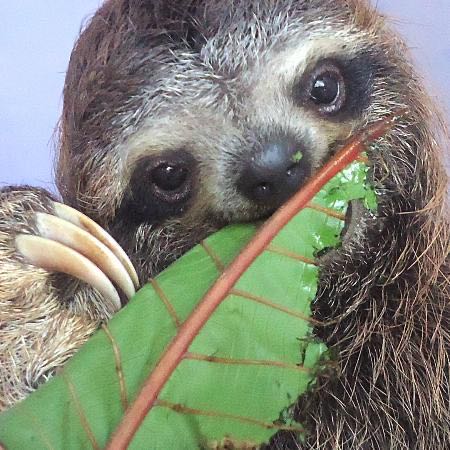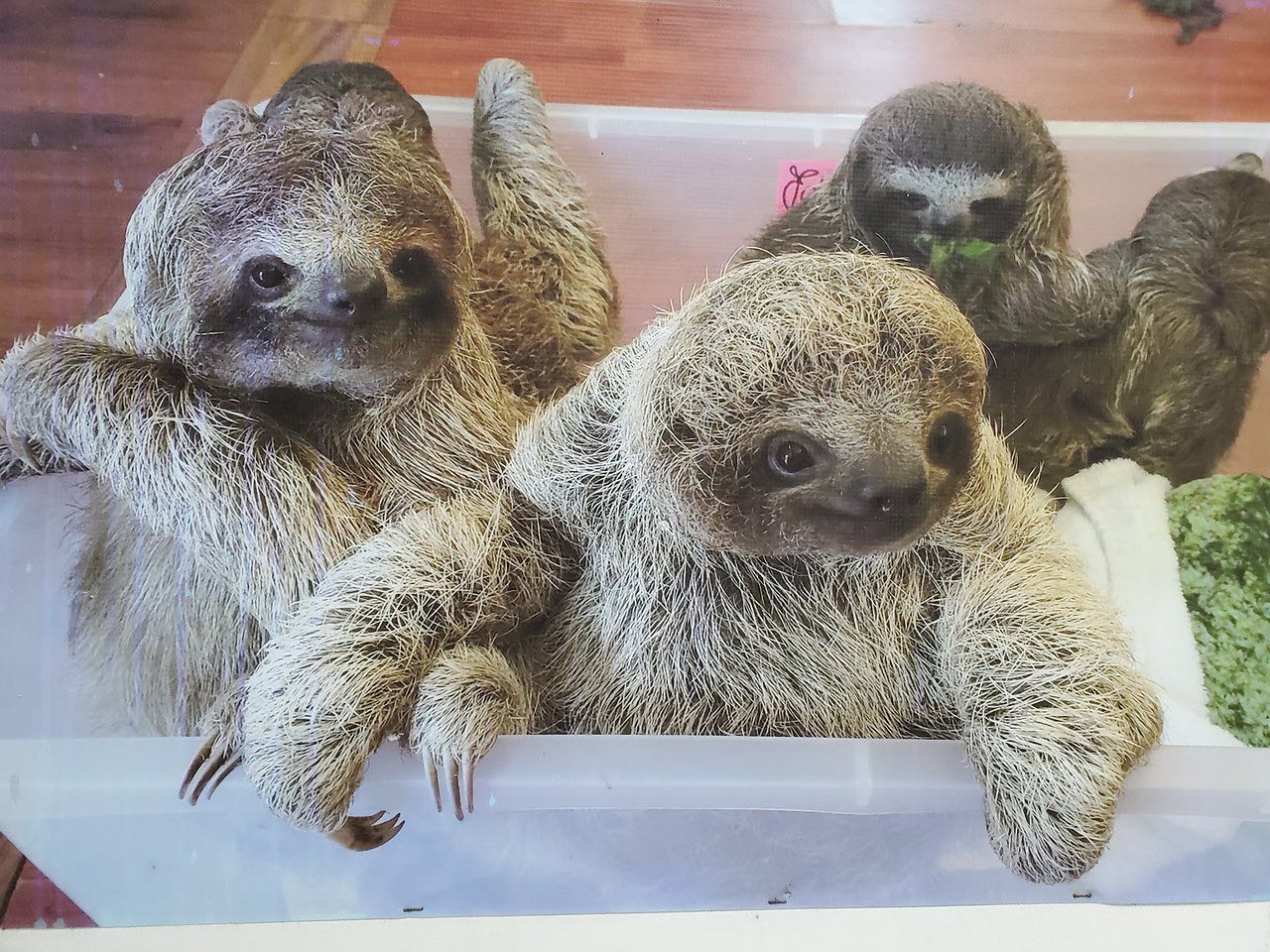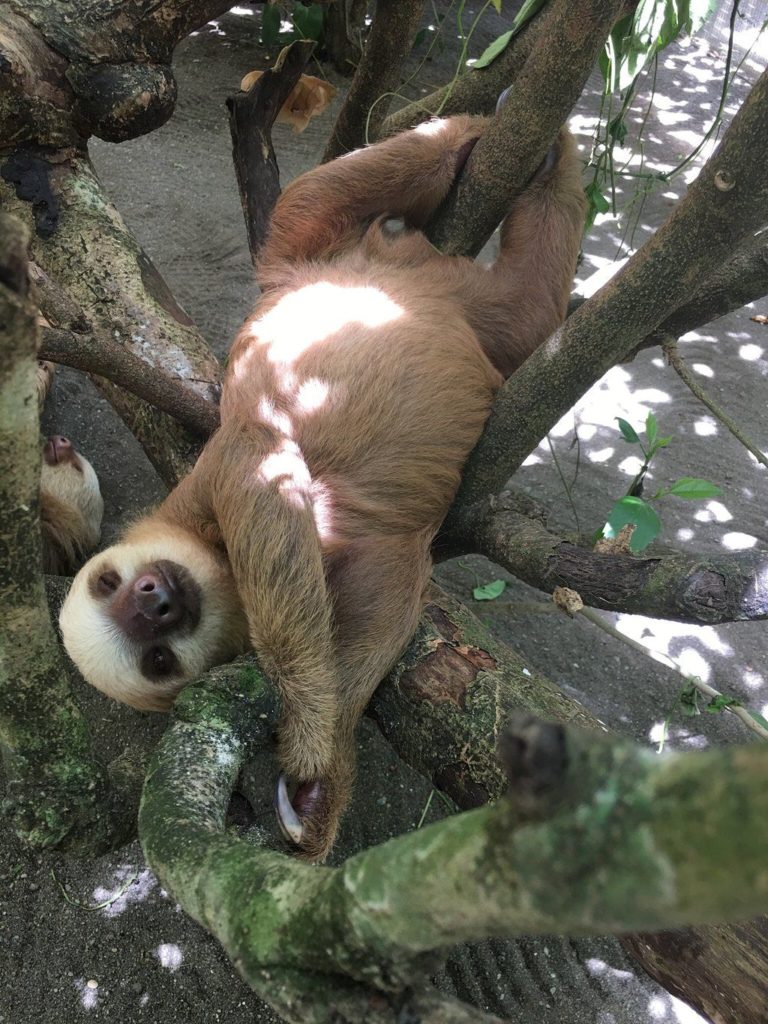Sloths – Not Just About Costa Rica
Originally by Nexus Feng 02/15/2020
Introduction
 Throughout these two years, the Bamboo Club, a non-profit organization founded by me, has been focusing on promoting the concept of animal conservation. Pandas are the first species that the Bamboo Club focused on because of their status as a diplomatic symbol of China as well as its special body colors which make it adorable and well-known by most of the people around the world. In January 2020, I had a chance to visit Costa Rica, a country located in Central America, and had the chance to get to know about sloths, animals specific to Central America. After a such visit, I realized that there are many similar points between conservation of both pandas and sloths. Therefore, in this article, I will briefly introduce some special characters of sloths, followed by the efforts paid by Costa Rica or countries in Central America in the protection of sloths. The status of sloths to Costa Rica is as high as pandas to China, so this article will also contain a comparison of the protective measures implemented by these two countries towards their national animals. Finally, there will be an analysis on the effectiveness of those protection measures on sloths.
Throughout these two years, the Bamboo Club, a non-profit organization founded by me, has been focusing on promoting the concept of animal conservation. Pandas are the first species that the Bamboo Club focused on because of their status as a diplomatic symbol of China as well as its special body colors which make it adorable and well-known by most of the people around the world. In January 2020, I had a chance to visit Costa Rica, a country located in Central America, and had the chance to get to know about sloths, animals specific to Central America. After a such visit, I realized that there are many similar points between conservation of both pandas and sloths. Therefore, in this article, I will briefly introduce some special characters of sloths, followed by the efforts paid by Costa Rica or countries in Central America in the protection of sloths. The status of sloths to Costa Rica is as high as pandas to China, so this article will also contain a comparison of the protective measures implemented by these two countries towards their national animals. Finally, there will be an analysis on the effectiveness of those protection measures on sloths.
Sloths
Sloth is not an unfamiliar animal for us. We may have seen or heard of it in cartoons, shows, etc. Sloths are special to the tropical forests of South and Central America. They are mammals famous for their slow movement, a drastic 4 meters every minute. Although sloths have long legs, the reason that they are unable to have fast movement is because they can only drag themselves using their claws on the ground, which is quite a special way of movement among mammals. Another reason for their slow movement is that their digestion system works very slow, so they have to spend most of the time digesting the food they have eaten, making them have no extra energy for other activities. The movement of sloths is slow, so is their eyesight and hearing. Sloths cannot see things clearly and accurately, so they mostly rely on touching and smelling things to identify direction and objects like food. Sloths are able to climb trees, but most of them prefer hanging horizontally on trees, and in fact, they would spend most of their life hanging upside down on the trees. It has been discovered that the organs of sloths are attached to their rib cage, so when they are hanging upside down for a long period of time, the organs won’t be crowded together, and won’t affect their breathing pathway. However, they don’t always stay on the trees. Sloths would move to the ground once about every six days so that they can urinate and defecate.
Sloths and pandas
Like pandas, sloths are also solitary animals, they like to live alone. They are aggressive against sloths of the same sex. When talking about pandas, we would have the view that pandas are lazy, with their main daily activities being sleeping and eating bamboo. This is exactly the same with sloths. Sloths would spend 15 to 20 hours for sleeping each day. For wild sloths, they also spend 8 to 9 hours doing nothing but just sleep.

There are still a relatively large number of sloths in Costa Rica, but sloths from Brazil and Panama have become endangered. The population and living of sloths depend heavily on the environment of tropical rain forests. However, due to overwhelming human activities, many forests are destroyed, destroying the places where sloths live in. With a lack of lush forests, sloths will lose their shelters and food resources. As mentioned above, sloths love to hang on trees for most of the time, so if there is a lack of trees for them to stay, they have to move to the ground. However, such action is extremely dangerous for sloths, because their slow movement on the ground would attract enemies like wildcats and harpy eagles. Although sloths are not popular foods among other animals because of their long claws and fur, they would still be attacked easily by their enemies when they are on the ground.
Efforts by the local people are not enough. Therefore, the government of Costa Rica has worked together with local police, local people, and travel companies to ensure the acts of tourists do not destroy the species. For example, when tours arrive at the beach, the tour guide would warn people of the things that are prohibited to be done, such as not being noisy and not using lights against . Moreover, part of the tour fees would be used on local construction and reimbursements for local conservation organizations’ expenses.
Apart from destroying sloths’ habitats, the peaceful living of sloths is also affected by human beings. If we browse through the internet now, we can easily find travel companies promoting visits to sloths and the chances of taking photos with them. For example, investigations have shown that in Manaus, one of the cities in the Amazon, travel companies offer chances for tourist to take photos by holding these wild animals in 94% of short-distance travels . In such journeys, tourists are usually allowed to hold sloths and take pictures, which would in turn be too noisy and uncomfortable for sloths as they don’t like hugs. Moreover, a large amount of tourist visits would affect the time for sloths to sleep, and they would start to be frightened of their surroundings and people.

Protection to sloths
With pandas, we have cooperation between countries and organizations in doing researches and developing new products for improving their health and living conditions. People also established research centers and invented nourishments to help with the panda’s eating and digestion. Protections for sloths are similar. Locally in Costa Rica, there is a place called the Cincinnati Zoo and the Botanical Garden. It is an organization that brings science-based educations to students and the community to raise people’s awareness towards conservation of natural resources and wildlife. The zoo also works together with The Sloth Institute Costa Rica (TSI), a non-profit organization focusing on research and education on the health and behavior of newly released, captive, and wild sloths.
In Costa Rica, there’s another place called the Sloth Sanctuary of Costa Rica, which was an officially authorized sloth rescue center in 1997 . This center was founded by two young girls, Judy Avey-Arroyo and Luis Arroyo, who received a baby sloth from three neighbor girls after they found it staying next to an adult sloth that has died in a car accident. The center aims to rescue and research sloths that are encountering dangerous situations or with injuries and are unable to survive alone in the wild. Volunteer staff members in the center also focus on helping these sloths to adapt to the nature after their recovery. The center also offers programs and visits to educate people about protecting the forest and the sloths’ habitat. Throughout these years, the center has helped many injured sloths to recover and get released to the nature .
The World Wildlife Fund (“WWF”) has worked together with communities, companies, and governments of countries that have sloths to preserve sustainable forests. The WWF has established the Global Forest and Trade Network to link companies in different countries together, aiming to support their business while maintaining the natural habitat of forests . Under this network, participants would work out methods to use woods or resources obtained from forests more efficiently so that they can reduce a rapid consumption of forest resources, which would reduce the reverse effects brought to the habitats of sloths. On its website, there’s also information on what different stakeholders, like forest managers, buyers of timber products, and financial institutions, can do to help practice forest management. This network has already involved different forests or stakeholders located in Russia, Mexico, Africa, Congo and many other places .
Protection to these valuable species is not a duty of a single country, but an obligation of the whole world. From the preservation of pandas and sloths, we can see that working in partnership is the best choice to invent the most suitable ways for the health and living of these animals, because experts in different countries can offer and exchange their knowledge and techniques together.
Apart from physical help to sloths, there’s also an adoption program to raise the public’s awareness on sloths in Costa Rica. However, such adoption doesn’t mean really taking a sloth’s home, but a symbolic adoption. Adopters would pay for the adoption fee and they would be given an Adoption Certificate stating the orphaned sloth that has been adopted by them. What’s more, adopters can also have the chance to watch the sloth they have adopted live through Skype. In China, there’s also a similar adoption system towards pandas. Panda adopters would receive certificates, and annual reports on the health and living status of the panda they have adopted. Such adoption systems can effectively provide funds for research centers to conduct further research, offer protection to pandas and conduct education programs. Meanwhile, such adoption system also allows panda-lovers to symbolically own a panda.


Bibliography
1. World Animal Protection, 2019, A close up on cruelty.
2. Sloth Sanctuary Costa Rica, 2019, About Us.
3. Sloth Sanctuary Costa Rica, 2019, Release Story.
4. World Wildlife Fund, 2019, The Global Forest & Trade Network.
5. World Wildlife Fund, 2019, Newsroom.